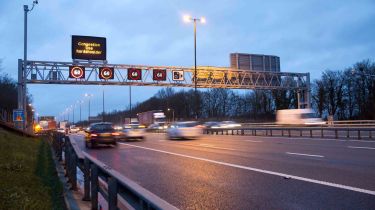What is a smart motorway?
Everything you need to know about variable speed limits and where to pull over on a ‘smart’ motorway

Smart motorways were first trialled in 2006 in an effort to improve traffic flow and reduce congestion during rush hour. The monitored section of motorway with all lanes active proved successful and the scheme was seen as an alternative to expensive and disruptive road-widening schemes.
The smart motorway was rolled out onto some of the busiest stretches of road from 2013. There are three different varieties of smart motorway, managed by regional control rooms.
 Top 10 best motorway cars 2025
Top 10 best motorway cars 2025
Smart motorways have remained controversial, though, because of reports that less than half of all drivers are aware of what they are for and, more importantly, where they can pull over safely on them. This strengthens existing concerns that smart motorways are dangerous.
Controlled smart motorways
Controlled smart motorways can be identified by the information shown on overhead gantry signs. They display open and closed lanes as well as variable speed limits. By altering the speed motorists can travel at and the lanes in which they can travel, the idea is that control-room operatives can make motorways safer and keep traffic moving when there’s congestion.
A red ‘X’ above any lane on an overhead sign means the lane is closed and driving in it is illegal. The police can give you a fine of £100 and add three points to your licence for driving in a closed lane, or decide on a more severe punishment if they think your driving is dangerous or careless. Lanes can be closed due to broken-down vehicles or crashes, or to allow emergency vehicles to reach incidents more easily.
Dynamic hard shoulder smart motorways
Dynamic hard shoulder smart motorways make use of the variable speed limits and closeable lanes described above, but also bring the hard shoulder into play when required.
While a hard shoulder is traditionally a place solely for emergencies and broken-down vehicles, dynamic hard shoulders can be driven on when opened by control-room staff. This is done when extra capacity is required on the motorway.
Dynamic hard shoulders are normally closed by default, though, and remain separated from the rest of the motorway by a solid white line. Gantry and verge-mounted signs will make it obvious when you can drive on a dynamic hard shoulder and the speed limit will be displayed above them. If the sign above the hard shoulder is blank or features an ‘X’, this means it’s closed.
Smart motorways that make use of dynamic hard shoulders feature ‘refuge areas’. These lay-bys must be no more than 1.6 miles apart and a programme to paint their surfaces orange is being rolled out to improve their visibility. If you’re driving at 60mph, you should pass one, on average, every 75 seconds.
All-lane-running smart motorways
All-lane-running smart motorways essentially turn the hard shoulder into a permanent extra lane, and also make use of variable speed limits. As with dynamic hard shoulder smart motorways, all-lane-running smart motorways feature closeable lanes, as well as refuge areas for motorists experiencing breakdowns or emergencies.
Unlike dynamic hard shoulder smart motorways, however, on all-lane-running smart motorways there’s no solid white line between the motorway and hard shoulder. The latter is open by default and only closes when an incident occurs or emergency access is required.
Smart motorway driving tips
Smart motorways are controlled by electronic signs on gantries and verge-mounted displays. Pay attention to these and follow the instructions they show.
If you or your car experiences difficulties on an all-lane-running smart motorway or a dynamic hard shoulder motorway where the hard shoulder is open to traffic, make your way to the next refuge area or pull off at the next exit if at all possible. Refuge areas are marked by blue signs and all feature SOS telephones. Use this to alert the authorities if you have to pull over into a refuge area.
If you can’t make it to a refuge area on a smart motorway where the hard shoulder is being used as an extra lane, or if the next junction is out of reach, pull over as far as you can to the side of the road of the nearside (furthest left) lane and put your hazard-warning lights on.
If you find yourself in this situation, Highways England’s advice is “Exit the vehicle via the left-hand door, if you can and it is safe to do so, and wait behind the barrier if possible”.
If you can’t make it to the hard shoulder, a refuge area, the next exit or the nearside verge and are forced to stop in a live lane, put your hazard warning lights on and contact the emergency services. The smart motorway control team should spot you, or be alerted to your peril by the build-up of traffic behind you.
One last piece of advice: Highways England says that “If for any reason you cannot, or believe that it would be unsafe to exit the vehicle, or there is no other place of relative safety to wait, you should remain in the vehicle with your seatbelt on.”
Are smart motorways dangerous?
An investigation by BBC’s Panorama TV programme has resulted in an urgent review of the UK’s smart motorway network. The investigation found that the number of near-misses (incidents with “the potential to cause injury or ill health”) was 20 times higher on one short section of the M25 since the hard shoulder was removed in 2014. A total of 72 near misses were recorded in the five years before the introduction of smart motorways, compared to 1,485 in the five years since. That same section of motorway has seen 38 deaths since 2014.
A Freedom of Information (FoI) request from Panorama to Highways England also found that one gantry sign had not been working for almost a year. In addition, the emergency laybys on all-lane-running sections of smart motorway should be around 600m apart, but in some places these are over two miles apart.
A radar system is set to be rolled out onto the UK’s smart motorways in the next three years, which will be able to instantly spot when cars have broken down. At the moment, occupants of stranded cars are waiting an average of 17 minutes before they’re spotted, and the same time again before recovery arrives.
The transport secretary, Grant Shapps, said, “We absolutely have to have these as safe or safer than regular motorways or we shouldn’t have them at all.”
How are smart motorways being made safer?
While the Department for Transport (DfT) maintains smart motorways are “comparatively the safest roads in the country in terms of fatality rates”, it announced in March 2020 the rollout of new all lane running smart motorways in the UK will be paused until 2025. During this time period, the DfT will gather safety data on the country’s existing smart motorway network, and use the findings to make more informed decisions on future smart motorway plans.
In addition, it was confirmed measures were being introduced to improve the safety on existing smart motorways. These include reducing the distance between refuge areas from the current 1.6 miles to a maximum of one mile, with the DfT claiming smart motorway refuge areas will on average be 0.75 miles apart from one another. At least another 150 extra emergency areas will also be rolled out across the smart motorway network by 2025.
As part of measures to reduce the confusion around smart motorways, all of the remaining dynamic hard shoulder smart motorways will be converted into all lane running roads before April 2025. This, the DfT argues, will improve safety by preventing drivers from being confused over which motorways allow them to drive on the hard shoulder or not.
Other upgrades to the UK’s smart motorway network include upgraded cameras, more signs to inform drivers of upcoming emergency areas and additional technology that can inform operators when there’s a stopped vehicle in a live lane. According to National Highways (the new name for Highways England), this work is on track to be completed by September 2022.
Motorway driving made simple
Recommended

Beat the Easter weekend traffic: secrets of a stress-free car getaway
Most Popular
Tips & advice

Car dashboard warning lights: what does each symbol mean?

Electric car charging stations: public networks, charger types, apps and maps







